6 Trends Driving TMF Strategy:
From Big Data to TMF RM V4
Download PDF
Leaders connected at the Veeva TMF Innovation Forum to discuss the evolution of TMF from a file repository to a strategic tool for trial management and oversight. From leveraging big data insights to harnessing the power of audit trails for automation, TMF leaders at top biopharmas and CROs are delivering broader value across clinical trial processes.
-
Strategic TMF delivers broader value, from start-up and monitoring to acquisitions
TMF is getting more strategic, and companies are taking notice. “For the first time, TMF has a seat at the table in our clinical trial process management transformation,” says a top 10 biopharma’s director of clinical records management.
TMF teams are increasingly being asked to provide guidance for broader teams. For example, the top 10 biopharma developed a framework for strategic TMF partnership across all major clinical trial processes, from start-up and monitoring to acquisitions. When the company started a site engagement project, the director of clinical records management included the TMF team in its technology adoption and change management strategies.
“Our company invested in and recognized the importance of our group, and we’ll now nurture that partnership,” says the clinical records management director. TMF expertise at the table will translate into a more complete, higher-quality TMF with less redundancy and manual effort.
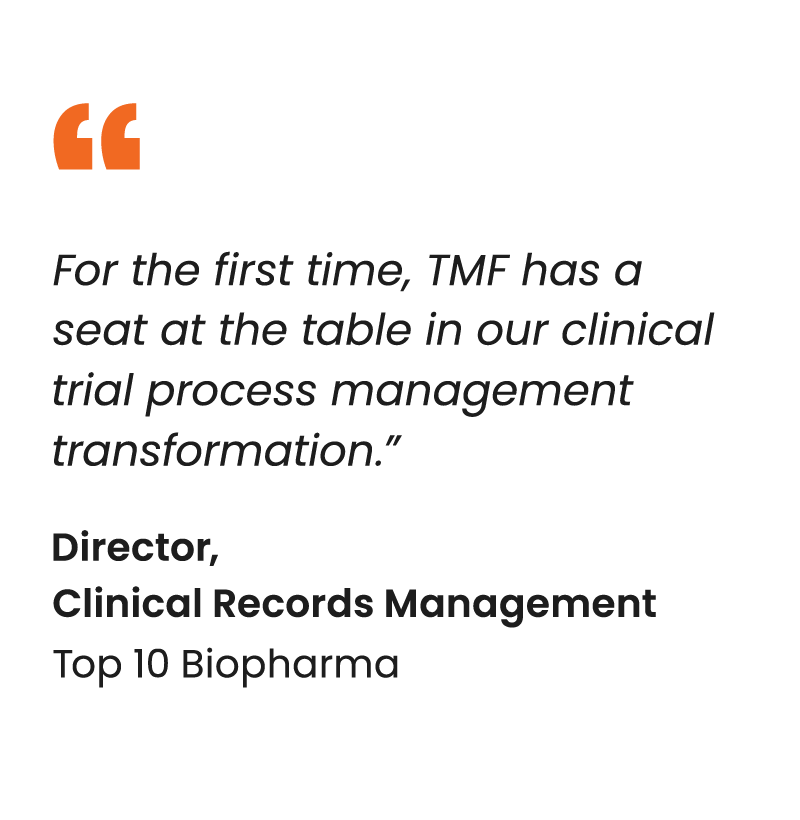
-
TMF Reference Model V4 encourages global TMF standards and interoperability
CDISC is set to launch the TMF Reference Model V4 in early 2027, addressing the industry’s shift toward a digital-first approach. It will focus on TMF data flow, interoperability, and harmonization.
The TMF is central to the clinical trial story, yet most of its data originates from various systems. V4, influenced by ICH E6 and ICH M11, will seek to improve how these systems connect and streamline data exchange.
A TMF operations lead at a large biopharma says the new version will inform their future initiatives, including reducing their filing structure from more than 600 document types to the standardized structure outlined in V4. “It’s not about replacing everything. It’s about evolving from a model that has served us to one that can support consistency as a global organization,” explains the TMF operations lead. “The shift will enhance our risk-based thinking and push us to be more explicit on how we apply it.”
CDISC also plans to engage with regulatory bodies to establish alignment and facilitate regulatory buy-in, a key activity to ensure adherence and widespread adoption.
V4’s development involves a large community effort, with significant volunteer contributions and global input. CDISC steering committee members are asking for community expertise and feedback in building the updated model.
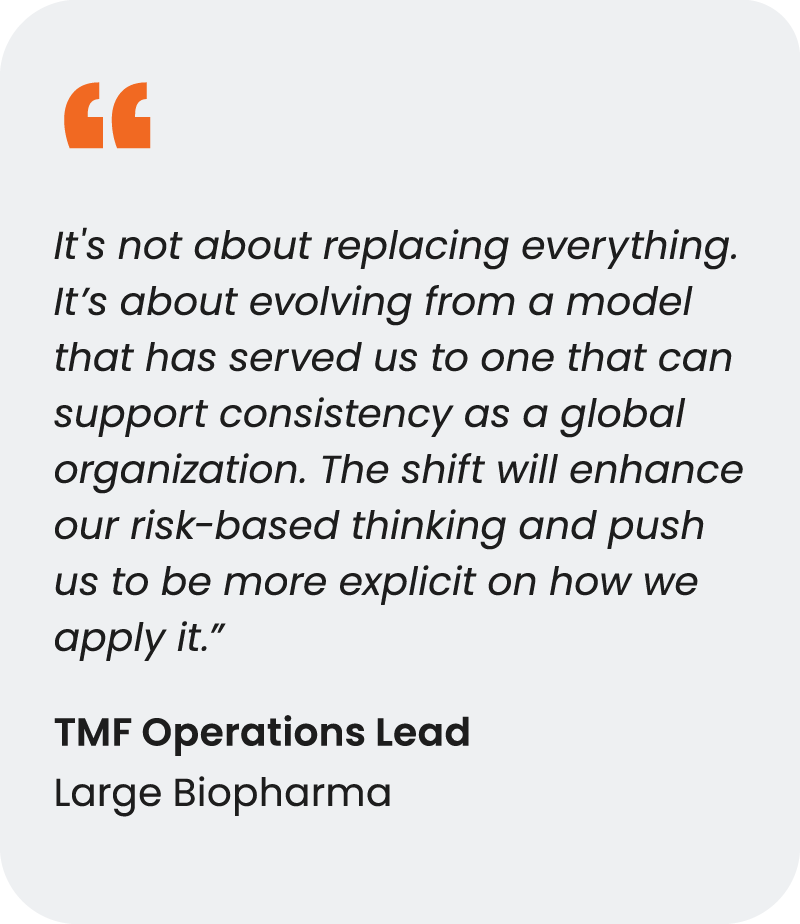
-
Big data is becoming central to informed eTMF decision-making
The intersection of TMF and “big data” is driving better insights, especially as biopharmas look for ways to effectively manage growing data volumes.
This development reflects a broader move in clinical trial execution toward a data-centric model, evolving the TMF from a file repository to a tool for trial oversight. One example of how this could work in practice is a TMF team using an API to extract the audit log to a data lake. The team can then analyze the information to target specific audit updates, like final document modifications. This kind of additional insight enables more confident decision-making and smarter risk management.
“TMF is an extraordinary resource of rich information about trial conduct, and it can become a true trial oversight tool and information hub,” says the director of clinical trial systems at a large biopharma.
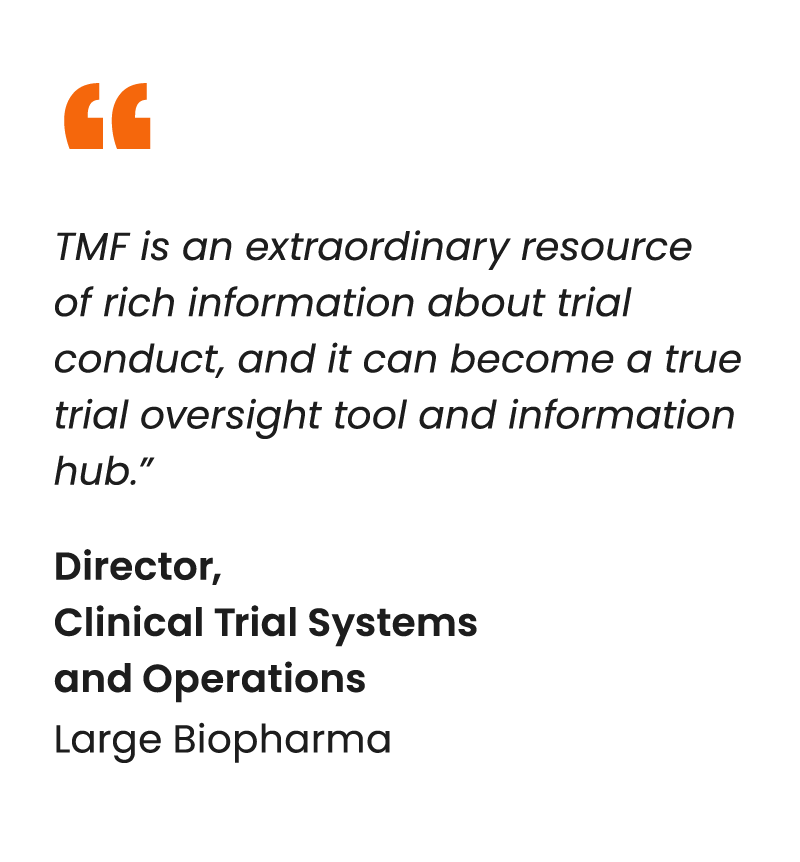
-
Audit trail strategies drive proactive and continuous inspection readiness
TMF leaders are focusing on audit trails, both as a proactive means to drive TMF health and a key area for regulators. The concept of “inspection readiness” is evolving to “inspection steadiness.” “Readiness” means preparing for an upcoming inspection, while “steadiness” means continuously preparing.
Enhanced audit trail reviews are crucial in inspection preparation. Biopharmas discussed differing use cases for system, document, and object-level audit trails, including:
- Case examples for CRO leadership about performance and quality
- Deletion logs to illustrate high-level information on document details and the purpose of deletion
- User activity reports to help identify individuals who need access to the eTMF
TMF leaders recommend identifying unexpected events and anomalies, as regulators and quality teams look for deviations from the norm. Systems can trigger alerts for specific activities, like large data downloads. One large biopharma’s TMF team randomly checks studies each quarter, selected based on the risk of inspection or compliance concerns. For each sampling, they review document data, ensure audit traceability, and run various reports.
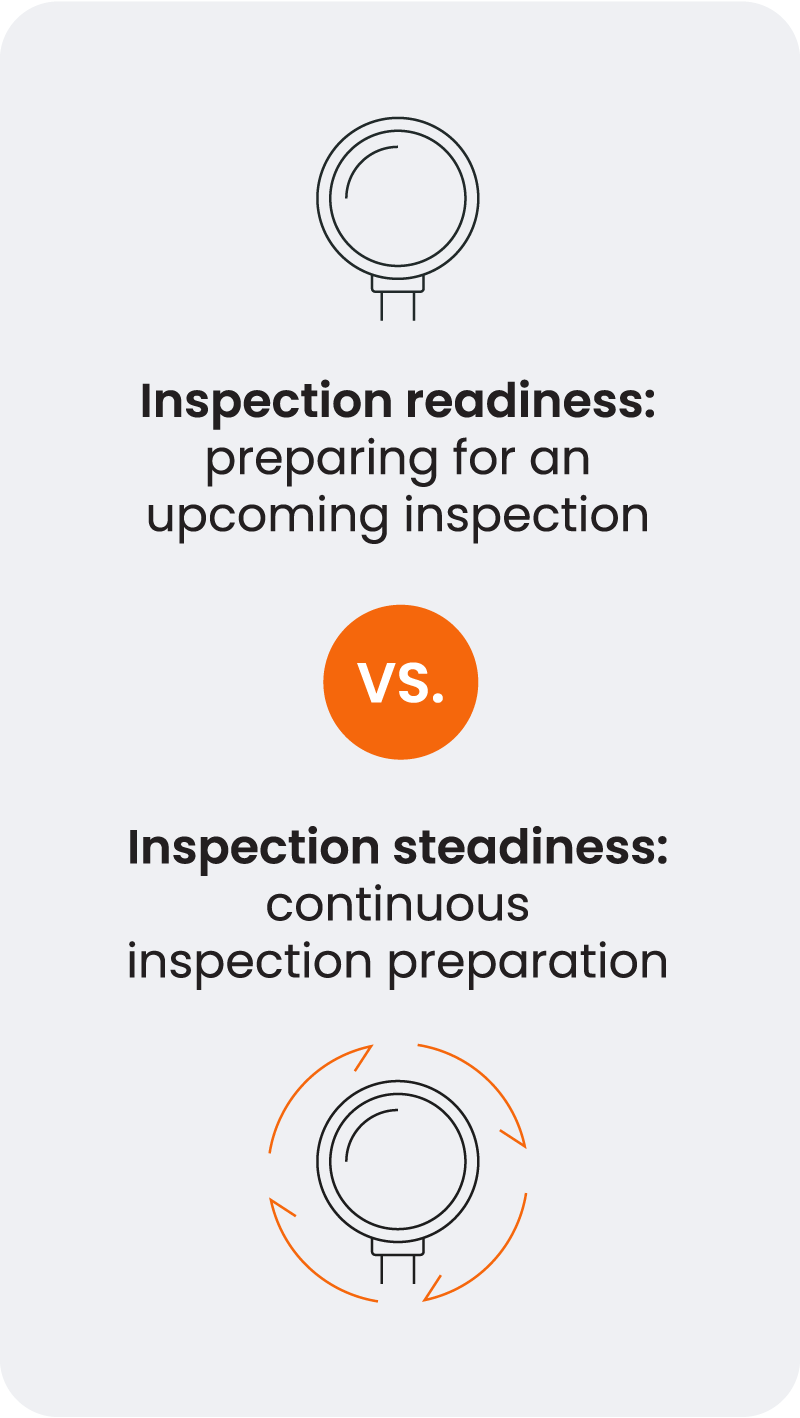
-
Prioritizing site collaboration improves TMF quality and reduces burden
Site collaboration is a critical focus for TMF leaders, as sites provide over 75% of the total document volume in the TMF. Biopharmas and CROs agree that enhancing site collaboration involves reducing manual work, standardizing document exchange, and fostering relationships.
Site burden is a key consideration for site engagement strategies. Biopharmas and CROs are cautious about giving sites another login and system to interact with, but recognize the importance of automation and technology. For example, one biopharma found that 25% of missing documents were related to site training. Another biopharma encounters similar document completeness challenges due to manual site document uploads.
To alleviate the workload, many biopharmas use a risk-based approach to evaluate documents. Sponsors have also seen enthusiasm from sites to implement solutions to improve site document exchange, reporting, and completeness.
In addition to technology solutions, personal relationships are essential to fostering a collaborative culture. Many biopharmas are looking toward more positive ways to encourage TMF completeness, rather than focusing only on audits. For example, one sponsor sends out a newsletter highlighting site successes.
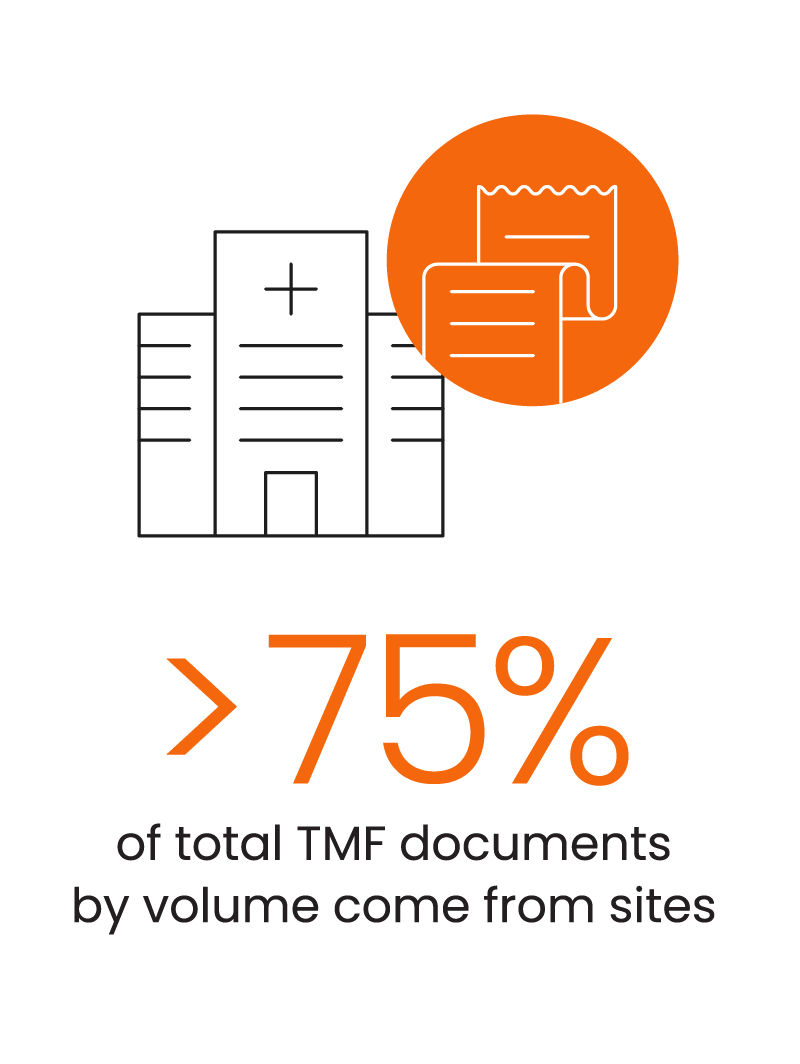
-
As ICH GCP E6(R3) nears final stages, biopharmas are refining CRO engagement models
With ICH GCP E6(R3) set to be finalized in July 2025, TMF leaders are refining sponsor-CRO partnerships to encourage clear communication, shared responsibility, and a commitment to quality. “Sponsor-CRO collaboration is essential for ongoing discussion, education, and flexibility to ensure a successful outcome,” says the senior director of clinical trial management at an emerging biopharma. “Ultimately, the sponsor is responsible for driving this partnership.”
Key partnership elements can include:
- Clear SOPs: Many biopharmas said clear SOPs help drive alignment across CROs, particularly if CROs work in the sponsor’s system and follow the sponsor’s SOPs.
- Early alignment: Aligning expectations from the RFP stage through study kick-off meetings is critical. One biopharma recommends a TMF kick-off meeting to review and launch the TMF Plan and TMF Index.
- Straightforward contracts: Contracts should define responsibilities for document ownership, upload procedures, and quality control.
- Standard metrics: Implement performance and user metrics to track CRO activity and ensure compliance with agreed-upon standards. One small biopharma uses what it calls a “mother dashboard” to align teams with standard and firm metrics.
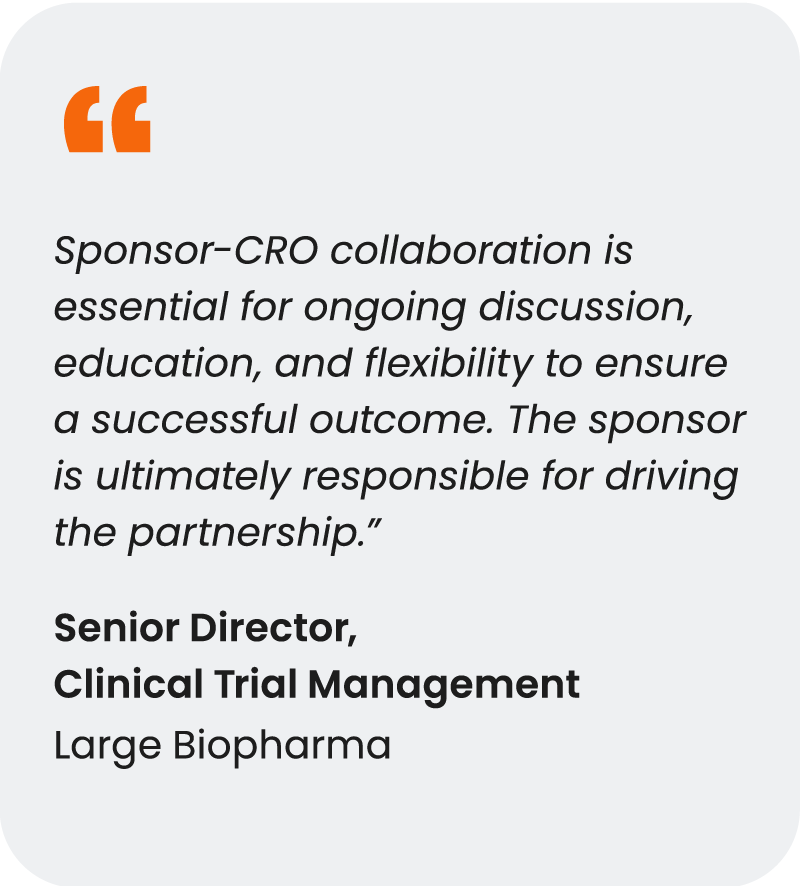
Continue the Discussion at Veeva Summit
To continue the discussion with TMF leaders on improving trial efficiency and inspection readiness,
register for Veeva R&D and Quality Summit in Boston this Sept. 2-4.